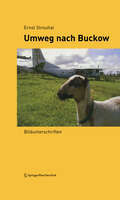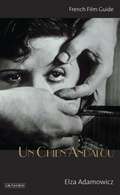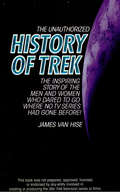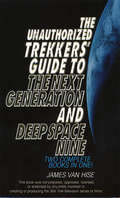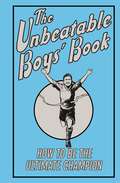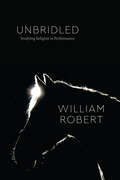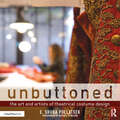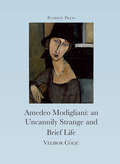- Table View
- List View
Umweg nach Buckow: Bildunterschriften (Edition Transfer)
„Umweg nach Buckow" enthält eine Vielzahl von Essays Ernst Strouhal’s aus den letzten Jahren, die sich der Themen Literatur, Spiel, Kunst, Politik und Reise annehmen. Auf unterschiedliche Art und Weise tragen die Texte, die sich programmatisch als „Bildunterschriften" verstehen, dem zusehends beliebigen „iconic turn" in den Medien und Kulturwissenschaften Rechnung, und reflektieren diesen kritisch. Auch wenn sich der Blick des Autors jeweils am Detail des Bildes und der Quelle entwickelt, so gilt das Interesse der Gegenwart. Das Spektrum des Bandes ist weit: Es reicht von der Begegnung des Autors mit Defoes Robinson, über Fragonard und die Kunst der Rätselmacher bis Arnold Schönberg, Marcel Duchamp und Bert Brecht.
(Un)Believing in Modern Society: Religion, Spirituality, and Religious-Secular Competition
by Jörg Stolz Judith Könemann Mallory Schneuwly Purdie Thomas Englberger Michael KrüggelerThis landmark study in the sociology of religion sheds new light on the question of what has happened to religion and spirituality since the 1960s in modern societies. Exposing several analytical weaknesses of today's sociology of religion, (Un)Believing in Modern Society presents a new theory of religious-secular competition and a new typology of ways of being religious/secular. The authors draw on a specific European society (Switzerland) as their test case, using both quantitative and qualitative methodologies to show how the theory can be applied. Identifying four ways of being religious/secular in a modern society: 'institutional', 'alternative', 'distanced' and 'secular' they show how and why these forms have emerged as a result of religious-secular competition and describe in what ways all four forms are adapted to the current, individualized society.
(Un)Believing in Modern Society: Religion, Spirituality, and Religious-Secular Competition
by Jörg Stolz Judith Könemann Mallory Schneuwly Purdie Thomas Englberger Michael KrüggelerThis landmark study in the sociology of religion sheds new light on the question of what has happened to religion and spirituality since the 1960s in modern societies. Exposing several analytical weaknesses of today's sociology of religion, (Un)Believing in Modern Society presents a new theory of religious-secular competition and a new typology of ways of being religious/secular. The authors draw on a specific European society (Switzerland) as their test case, using both quantitative and qualitative methodologies to show how the theory can be applied. Identifying four ways of being religious/secular in a modern society: 'institutional', 'alternative', 'distanced' and 'secular' they show how and why these forms have emerged as a result of religious-secular competition and describe in what ways all four forms are adapted to the current, individualized society.
Un/Certain Futures - Rollen des Designs in gesellschaftlichen Transformationsprozessen (Design #38)
by Marius Förster Saskia Hebert Mona Hofmann Wolfgang JonasWelche Rolle spielt Design in gesellschaftlichen Transformationsprozessen? Können Zukünfte und soziale Wirklichkeiten nachhaltig gestaltet werden - oder handelt es sich bei den Wirkungen gestalterischer Eingriffe um mehr oder weniger zufällige Reaktionen eigensinnig evolvierender sozialer Systeme auf gut gemeinte Interventionen? Wie wäre das »Bessere« zu definieren, besonders im Kontext von Nachhaltigkeit und der Debatte um eine notwendige »Große Transformation«? Im Aufspannen eines komplexen Netzes von Beiträgen aus Theorie und Praxis wird Design in diesem Band außerhalb disziplinärer Engmaschigkeit gedacht und nimmt soziale, ökologische, politische und ökonomische Herausforderungen ernst.
Un Chien Andalou: French Film Guide
by Elza AdamowiczIn 1929 Dalí and Buñuel produced a seventeen-minute film, Un chien andalou. On its first screening, Georges Bataille referred to it as 'that extraordinary film' penetrating so deeply into horror', while Federico García Lorca described it as 'a tiny little shit of a film'. Produced from a script said to be based on two dream images - a woman's eye slit by a razor, ants emerging from a hole in a man's hand - the film shocked audiences. It continues to fascinate, provoke, attract and alienate its viewers. Its eye-slitting sequence and use of dream-like images have influenced filmmakers from AlfredHitchcock to David Lynch.Elza Adamowicz's lucid critical guide to this most enigmatic of works offers new approaches to the film, exploring how it can be seen both within and beyond the confines of Surrealism and reviewing its openness to so many readings and interpretations. She reassesses Dalí and Buñuel's account of the film as a model surrealist work and its reception by the surrealist group. She situates the film within the social and cultural contexts of the 1920s,including those of melodramatic film, Spanish culture, surrealist iconography and gender construction. She assesses the film's resistance to a single interpretation and explores the role of the viewer (detective or dreamer?).
The Unauthorized History of Trek
by James van HiseOriginally published in 1997 and now available as an ebook. The inspiring story of the men and women who dared to go where no TV series had gone before!
The Unauthorized Trekkers’ Guide to the Next Generation and Deep Space Nine
by James van HiseYour complete guide to STAR TREK’s most popular progeny – both spectacular series guidebooks complete in one volume! Originally published in 1997, this edition covers all seven seasons of The Next Generation and seasons one and two of Deep Space Nine.
The Unbeatable Boys' Book: How to be the Ultimate Champion
by Huw DaviesThe Unbeatable Boys' Book shows boys everywhere how to become the ultimate champion. It is written by a professional sports coach. For the boy who loves to be the best at every sport he tries, this book contains tips and tricks to help him think like a winner and achieve champion status. It lets you learn how to perform stunts from different sports - from athletics, cycling, baseball and tennis to orienteering, triathlon and football. Be the best, beat the rest! This book shows: how to spin a ball like a pro; how to burp louder than a car horn; how to perfect a half-pipe; how to throw a ball accurately; how to perfect a racing dive; how to coach your football team; how to become a world-record holder; how to give a winner's interview; how to perfect a baton change; how to be the speediest speed skater; and, how to do the haka.
Unbehaust Wohnen: Konflikthafte Räume in Kunst - Architektur - Visueller Kultur (wohnen+/-ausstellen #7)
by Irene Nierhaus Kathrin HeinzUnbehaust Wohnen ist ein zentraler Teil der Geschichte und Theorie des Wohnens und wird dennoch häufig vergessen, verborgen, zum Diskurs allein von Spezialist_innen gemacht oder als ein ,Anderes' zu einem sichernden und ,eigentlichen' Wohnen verhandelt. Dem positiv gedachten Wohnen als Existenz und Heim/at steht also immer auch ein unbehaustes Wohnen zur Seite: Zerstörtes Wohnen in kriegerischen Konflikten, verlorenes Wohnen in Migrationen, temporäres Wohnen in Obdach- und Wohnungslosigkeit, prekäres Wohnen in ökonomischer, emotionaler und körperlicher Unversorgtheit, beängstigendes Wohnen in Subjektkrisen. Der Band nähert sich verschiedenen Zugängen und Ebenen eines Unbehausten aus kunst- und kulturwissenschaftlicher, philosophischer, historischer, ethnografischer, architekturtheoretischer, psychiatrischer sowie künstlerischer Perspektive.
Unbridled: Studying Religion in Performance (Class 200: New Studies in Religion)
by William RobertA study of religion through the lens of Peter Shaffer’s play Equus. In Unbridled, William Robert uses Equus, Peter Shaffer’s enigmatic play about a boy passionately devoted to horses, to think differently about religion. For several years, Robert has used Equus to introduce students to the study of religion, provoking them to conceive of religion in unfamiliar, even uncomfortable ways. In Unbridled, he is inviting readers to do the same. A play like Equus tangles together text, performance, practice, embodiment, and reception. Studying a play involves us in playing different roles, as ourselves and others, and those roles, as well as the imaginative work they require, are critical to the study of religion. By approaching Equus with the reader, turning the play around and upside-down, Unbridled transforms standard approaches to the study of religion, engaging with themes including ritual, sacrifice, worship, power, desire, violence, and sexuality, as well as thinkers including Judith Butler, Sigmund Freud, Karl Marx, Friedrich Nietzsche, and Jonathan Z. Smith. As Unbridled shows, the way themes and theories play out in Equus challenges us to reimagine the study of religion through open questions, contrasting perspectives, and alternative modes of interpretation and appreciation.
Unbridled: Studying Religion in Performance (Class 200: New Studies in Religion)
by William RobertA study of religion through the lens of Peter Shaffer’s play Equus. In Unbridled, William Robert uses Equus, Peter Shaffer’s enigmatic play about a boy passionately devoted to horses, to think differently about religion. For several years, Robert has used Equus to introduce students to the study of religion, provoking them to conceive of religion in unfamiliar, even uncomfortable ways. In Unbridled, he is inviting readers to do the same. A play like Equus tangles together text, performance, practice, embodiment, and reception. Studying a play involves us in playing different roles, as ourselves and others, and those roles, as well as the imaginative work they require, are critical to the study of religion. By approaching Equus with the reader, turning the play around and upside-down, Unbridled transforms standard approaches to the study of religion, engaging with themes including ritual, sacrifice, worship, power, desire, violence, and sexuality, as well as thinkers including Judith Butler, Sigmund Freud, Karl Marx, Friedrich Nietzsche, and Jonathan Z. Smith. As Unbridled shows, the way themes and theories play out in Equus challenges us to reimagine the study of religion through open questions, contrasting perspectives, and alternative modes of interpretation and appreciation.
Unbuilt Utopian Cities 1460 to 1900: Reconstructing Their Architecture And Political Philosophy
by Tessa MorrisonBringing together ten utopian works that mark important points in the history and an evolution in social and political philosophies, this book not only reflects on the texts and their political philosophy and implications, but also, their architecture and how that architecture informs the political philosophy or social agenda that the author intended. Each of the ten authors expressed their theory through concepts of community and utopian architecture, but each featured an architectural solution at the centre of their social and political philosophy, as none of the cities were ever built, they have remained as utopian literature. Some of the works examined are very well-known, such as Tommaso Campanella’s Civitas Solis, while others such as Joseph Michael Gandy’s Designs for Cottages, are relatively obscure. However, even with the best known works, this volume offers new insights by focusing on the architecture of the cities and how that architecture represents the author’s political philosophy. It reconstructs the cities through a 3-D computer program, ArchiCAD, using Artlantis to render. Plans, sections, elevations and perspectives are presented for each of the cities. The ten cities are: Filarete - Sforzina; Albrecht Dürer - Fortified Utopia; Tommaso Campanella - The City of the Sun; Johann Valentin Andreae - Christianopolis; Joseph Michael Gandy - An Agricultural Village; Robert Owen - Villages of Unity and Cooperation; James Silk Buckingham - Victoria; Robert Pemberton - Queen Victoria Town; King Camp Gillette - Metropolis; and Bradford Peck - The World a Department Store. Each chapter considers the work in conjunction with contemporary thought, the political philosophy and the reconstruction of the city. Although these ten cities represent over 500 years of utopian and political thought, they are an interlinked thread that had been drawn from literature of the past and informed by contemporary thought and society. The book is structured in two parts:
Unbuilt Utopian Cities 1460 to 1900: Reconstructing their Architecture and Political Philosophy
by Tessa MorrisonBringing together ten utopian works that mark important points in the history and an evolution in social and political philosophies, this book not only reflects on the texts and their political philosophy and implications, but also, their architecture and how that architecture informs the political philosophy or social agenda that the author intended. Each of the ten authors expressed their theory through concepts of community and utopian architecture, but each featured an architectural solution at the centre of their social and political philosophy, as none of the cities were ever built, they have remained as utopian literature. Some of the works examined are very well-known, such as Tommaso Campanella’s Civitas Solis, while others such as Joseph Michael Gandy’s Designs for Cottages, are relatively obscure. However, even with the best known works, this volume offers new insights by focusing on the architecture of the cities and how that architecture represents the author’s political philosophy. It reconstructs the cities through a 3-D computer program, ArchiCAD, using Artlantis to render. Plans, sections, elevations and perspectives are presented for each of the cities. The ten cities are: Filarete - Sforzina; Albrecht Dürer - Fortified Utopia; Tommaso Campanella - The City of the Sun; Johann Valentin Andreae - Christianopolis; Joseph Michael Gandy - An Agricultural Village; Robert Owen - Villages of Unity and Cooperation; James Silk Buckingham - Victoria; Robert Pemberton - Queen Victoria Town; King Camp Gillette - Metropolis; and Bradford Peck - The World a Department Store. Each chapter considers the work in conjunction with contemporary thought, the political philosophy and the reconstruction of the city. Although these ten cities represent over 500 years of utopian and political thought, they are an interlinked thread that had been drawn from literature of the past and informed by contemporary thought and society. The book is structured in two parts:
Unbuttoned: The Art and Artists of Theatrical Costume Design
by Shura PollatsekUnbuttoned: The Art and Artists of Theatrical Costume Design documents the creative journey of costume creation from concept to performance. Each chapter provides an overview of the process, including designing and shopping; draping, cutting, dyeing, and painting; and beading, sewing, and creating embellishments and accessories. This book features interviews with practitioners from Broadway and regional theatres to opera and ballet companies, offering valuable insights into the costume design profession. Exceptional behind-the-scenes photography illustrates top costume designers and craftspeople at work, along with gorgeous costumes in progress.
Unbuttoned: The Art and Artists of Theatrical Costume Design
by Shura PollatsekUnbuttoned: The Art and Artists of Theatrical Costume Design documents the creative journey of costume creation from concept to performance. Each chapter provides an overview of the process, including designing and shopping; draping, cutting, dyeing, and painting; and beading, sewing, and creating embellishments and accessories. This book features interviews with practitioners from Broadway and regional theatres to opera and ballet companies, offering valuable insights into the costume design profession. Exceptional behind-the-scenes photography illustrates top costume designers and craftspeople at work, along with gorgeous costumes in progress.
The Uncannily Strange and Brief Life of Amedeo Modigliani: An Uncannily Strange And Brief Life (Pushkin Blues Ser.)
by Velibor ColicThe life of the modernist painter Amedeo Modigliani (1884-1920) was chaotic and tragically brief. Spanning the last months of Modigliani's life, this evocative novel conjures up the strange workings of the painter's troubled - and often drug-fuelled - mind, and the manner in which his eccentricity expressed itself in his art. Colic's evocative novel captures the full essence of Modigliani's Bohemian lifestyle, and the colourful visitors who came and went through his Paris studio: among them his lover, Jeanne Hébuterne, and the prostitutes who occasionally modelled for him; and succeeds in conveying something of the intense artistic life of Paris in the first decades of the twentieth century.
Uncanny Cinema: Agonies of the Viewing Experience
by Murray PomeranceMurray Pomerance's latest book explores an encyclopedic range of films and television shows to demonstrate the difficulty of conveying the experience of viewing cinema through words and the medium of text. From On the Waterfront to Marriage Story, Uncanny Cinema illuminates that words and writing are in perilous waters when applied to cinema, similar to ungestured talk. The book begins with this problem using Julian Jaynes's thoughts on vocality and imagination before delving into three exploratory 'movements' arranged to alternately challenge, inspire, and confound the reader to question if we know what we think we know or even see what we think we see. The viewer is faced with disturbances, ruptures, and surprises that occur during the viewing experience, which Pomerance analyzes to stretch the sense of what we do and do not (or, possibly, cannot) know, particularly as we think, talk, and write about cinema.
Uncanny Cinema: Agonies of the Viewing Experience
by Murray PomeranceMurray Pomerance's latest book explores an encyclopedic range of films and television shows to demonstrate the difficulty of conveying the experience of viewing cinema through words and the medium of text. From On the Waterfront to Marriage Story, Uncanny Cinema illuminates that words and writing are in perilous waters when applied to cinema, similar to ungestured talk. The book begins with this problem using Julian Jaynes's thoughts on vocality and imagination before delving into three exploratory 'movements' arranged to alternately challenge, inspire, and confound the reader to question if we know what we think we know or even see what we think we see. The viewer is faced with disturbances, ruptures, and surprises that occur during the viewing experience, which Pomerance analyzes to stretch the sense of what we do and do not (or, possibly, cannot) know, particularly as we think, talk, and write about cinema.
Uncanny Creatures: Doll Thinking in Modern German Culture (Social History, Popular Culture, And Politics In Germany)
by Christophe KonéGermany held a monopoly on the manufacture and export of bisque toy dolls in Europe before WWI. Yet, dolls’ omnipresence in the material, visual, and literary culture of the modern German-speaking world has so far not been properly addressed. In demonstrating this cultural affinity for dolls, Christophe Koné draws upon a range of stories and seminal essays on dolls, as well as toys, sculptures, paintings, and photographs. He examines how E.T.A. Hoffmann’s romantic tale The Sandman (1815) has been a major source of inspiration for German-speaking doll makers because of how it centers imagination and inventiveness. Using Hoffmann’s tale as an early example of an amalgam between doll thinking and making in German culture, Koné shows how it initiated a genealogy of doll thinkers (Freud & Jentsch), writers (Rilke), painters (Kokoschka), photographers (Bellmer), and makers (Pritzel). Uncanny Creatures then explores how this unusual interest in human-like figures continues a long tradition of thought devoted to conceptualizing “things,” from Immanuel Kant’s theory of the thing-in-itself to Martin Heidegger’s lecture on the thing, and Eduard Mörike or Rainer Maria Rilke’s thing-poems. Because dolls occupy a liminal space—not quite things and more than mere objects—they appear as uncanny creatures which have held a fascination for writers, thinkers, and artists alike. Uncanny Creatures moves past the Freudian discourse of fetishism to propose a new reading of doll artifacts in German culture centered on their ability to evoke a feeling of uncertainty and unsettlement in the viewer.
The Uncanny Valley in Games and Animation
by Angela TinwellAdvances in technology have enabled animators and video game designers to design increasingly realistic, human-like characters in animation and games. Although it was intended that this increased realism would allow viewers to appreciate the emotional state of characters, research has shown that audiences often have a negative reaction as the human
The Uncapturable: The Fleeting Art of Theatre (Theatre Makers)
by Rubén SzuchmacherThe Uncapturable is a wide-ranging reflection on the art of the mise en scène from the perspective of leading Argentinian theatre director Rubén Szuchmacher. It offers a timely and concise, though comprehensive, survey of the role and responsibility of the theatre director from the earliest times to the twenty-first century. Szuchmacher defines theatre as the confluence of four art forms - architecture, visual art, sound and literature - whose works only truly exist in the moment of encounter with an audience. He argues that, by taking full account of these four art forms, analysing them in detail and engaging thoughtfully with the many specialists who come together to bring a mise en scène into being, the director of today can still create work that innovates and inspires. The Uncapturable is as valuable to the apprentice director emerging from their training as it is to the veteran in need of fresh reflection. Szuchmacher draws on the unique learnings gleaned from working in Argentina, be it the impact on theatre of politics, the need for inventiveness in times of hardship, the phenomenon of Argentine 'circus theatre' or the adaptation of literary giants such as Borges, affording the Anglophone reader an alternative perspective on the ideas of theatre we often take for granted.Szuchmacher offers a unique blend of global knowledge, historical awareness and a pragmatic, resourceful and creative approach from a theatre artist working in Latin American through decades of change. The book is translated from the Spanish by William Gregory.
The Uncapturable: The Fleeting Art of Theatre (Theatre Makers)
by Rubén SzuchmacherThe Uncapturable is a wide-ranging reflection on the art of the mise en scène from the perspective of leading Argentinian theatre director Rubén Szuchmacher. It offers a timely and concise, though comprehensive, survey of the role and responsibility of the theatre director from the earliest times to the twenty-first century. Szuchmacher defines theatre as the confluence of four art forms - architecture, visual art, sound and literature - whose works only truly exist in the moment of encounter with an audience. He argues that, by taking full account of these four art forms, analysing them in detail and engaging thoughtfully with the many specialists who come together to bring a mise en scène into being, the director of today can still create work that innovates and inspires. The Uncapturable is as valuable to the apprentice director emerging from their training as it is to the veteran in need of fresh reflection. Szuchmacher draws on the unique learnings gleaned from working in Argentina, be it the impact on theatre of politics, the need for inventiveness in times of hardship, the phenomenon of Argentine 'circus theatre' or the adaptation of literary giants such as Borges, affording the Anglophone reader an alternative perspective on the ideas of theatre we often take for granted.Szuchmacher offers a unique blend of global knowledge, historical awareness and a pragmatic, resourceful and creative approach from a theatre artist working in Latin American through decades of change. The book is translated from the Spanish by William Gregory.
Uncertain Images: Museums And The Work Of Photographs
by Elizabeth Edwards Sigrid LienAlmost all museums hold photographs in their collections, and museum professionals and their audiences engage with photographs in a myriad of ways. Yet despite some three decades of critical museology and photographic theory, and an extensive debate on the politics of representation, outside art museums, almost no critical attention has been given specifically to the roles, purposes and lives of these photographs within museums. This book brings into focus the ubiquitous yet entirely unconsidered work that photographs are put to in museums. The authors' argument is that there is an economy of photographs in museums which is integral to the processes of the museum, and integral to the understanding of museums. The international contributors, drawn from curators and academics, reflect a range of visual and museological expertise. After an introduction setting out the range of questions and problems, the first part addresses broad curatorial strategies and ways of thinking about photographs in museums. Shifting the emphasis from curatorial practices and anxieties to the space of the gallery, this is followed by a series of case studies of exhibitionary practices and the museum strategies that support them. The third section focuses on the role of photographs in the museum articulation of ’difficult histories’. A final section addresses photograph collections in a digital environment. New technologies and new media have transformed the management, address and purposing in photographs in museums, from cataloguing practices to streaming on social media. These growing practices challenge both traditional hierarchies of knowledge in museums and the location of authority about photographs. The volume emerges from PhotoCLEC, a HERA funded project on museums and the photographic legacy of the colonial past in a postcolonial and multicultural Europe.
Uncertain Images: Museums And The Work Of Photographs
by Elizabeth Edwards Sigrid LienAlmost all museums hold photographs in their collections, and museum professionals and their audiences engage with photographs in a myriad of ways. Yet despite some three decades of critical museology and photographic theory, and an extensive debate on the politics of representation, outside art museums, almost no critical attention has been given specifically to the roles, purposes and lives of these photographs within museums. This book brings into focus the ubiquitous yet entirely unconsidered work that photographs are put to in museums. The authors' argument is that there is an economy of photographs in museums which is integral to the processes of the museum, and integral to the understanding of museums. The international contributors, drawn from curators and academics, reflect a range of visual and museological expertise. After an introduction setting out the range of questions and problems, the first part addresses broad curatorial strategies and ways of thinking about photographs in museums. Shifting the emphasis from curatorial practices and anxieties to the space of the gallery, this is followed by a series of case studies of exhibitionary practices and the museum strategies that support them. The third section focuses on the role of photographs in the museum articulation of ’difficult histories’. A final section addresses photograph collections in a digital environment. New technologies and new media have transformed the management, address and purposing in photographs in museums, from cataloguing practices to streaming on social media. These growing practices challenge both traditional hierarchies of knowledge in museums and the location of authority about photographs. The volume emerges from PhotoCLEC, a HERA funded project on museums and the photographic legacy of the colonial past in a postcolonial and multicultural Europe.
Uncertain Projective Geometry: Statistical Reasoning for Polyhedral Object Reconstruction (Lecture Notes in Computer Science #3008)
by Stephan HeuelAlgebraic projective geometry, with its multilinear relations and its embedding into Grassmann-Cayley algebra, has become the basic representation of multiple view geometry, resulting in deep insights into the algebraic structure of geometric relations, as well as in efficient and versatile algorithms for computer vision and image analysis. This book provides a coherent integration of algebraic projective geometry and spatial reasoning under uncertainty with applications in computer vision. Beyond systematically introducing the theoretical foundations from geometry and statistics and clear rules for performing geometric reasoning under uncertainty, the author provides a collection of detailed algorithms. The book addresses researchers and advanced students interested in algebraic projective geometry for image analysis, in statistical representation of objects and transformations, or in generic tools for testing and estimating within the context of geometric multiple-view analysis.
